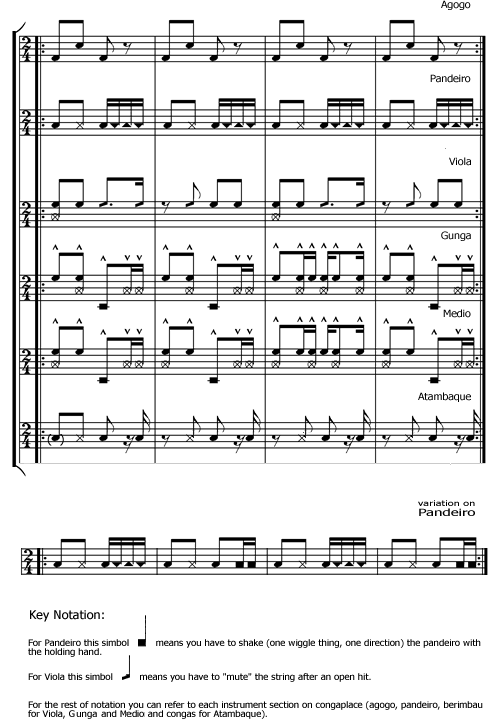RHYTHM
INFO
Gunga initiates the Jogo (Game) by playing constant open 16th
notes, (as shown at the bottom), then comes Medio, and then
Viola,(all
enter in apprixcimately the same way, 16th notes, or sometimes
8th notes in triple). If a ladainha is sung then, (which is
usually the case in Angola), other instruments enter only when
the chorus begins, in this order: pandeiro, atambaque, agogo,
reco reco. Sometimes the instruments come in before the ladainha
begins, these has usually to do with personal preference, and
how it is done at different Grupos differs. This is how I'v
learn't and understood the rhythms, and how I'v found they
sound
good. Theres about as many ways of playing, and combining these
rhythms as there are Mestres, if not even more.
When the actual playing begins the Mestre de Roda,(playing
Gunga), dips the head of the Berimbau while playing constant
16th notes. This initiates the game. Only to mark the begining
of each game is the gunga dipped, but otherwise all signals
are the same, to end each game and to end the whole Jogo. All
the signals are played long enough to catch the attention of
the players.
Most variations (improvisation), is done by viola but medio
and gunga also do variations according to the feeling. In São
Bento Grande all insruments enter before the songs begin.
In the rhythm noted the third bar is a variation
and is not compulsory and not even advisable to play all the
time. Pandeiro can play the rhythms bar two is just a variation
of bar one, (plus when playing for long periods of time its
easier). The noted viola rhythm is called Angolinha, and the
noted Medio rhythm in Angola is called São Bento Pequena.
AUTHOR (of
this version)
by Timo Tuhkanen
SHEET MUSIC
- played slowly -
